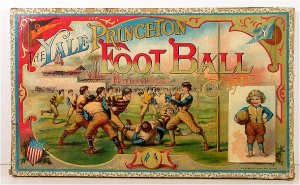Yale Princeton Football Game 1895
7th Mar 2020
We are always amazed at the prices vintage collegiate board games fetch. Our latest example is no different. This version is slightly different than the previous version of the Yale Princeton game we featured before.
This one, made by McLoughlin Brothers sold for $1,700. As you can see the box was in good condition but several of the playing pieces were missing.
A rare board game made in 1895 by the McLoughlin Bros of New York is called The Yale and Princeton Foot Ball Game. McLoughlin Brothers was an early maker of board games, beginning in 1858. It also produced early games such as Grandmama’s Improved Game of Useful Knowledge (1887), The Christmas Goose (1890), The Errand Boy (1891). They produced a series of interesting games until they were bought out by Parker Brothers in 1920.

It is actually referring to a 19th century rugby game. The beautifully done lythographed cover, is a real gem The playing board was also lined with fantastic lytho scenes of game action.
The instructions are on the inside cover and there are some game pieces (wooden markers). The game also came two spinner “indicators”.

A copy of the game sold recently at auction for $200. The item that was sold was in decent condition with the sides of the box intact but have some scotch tape holding some of it together. The cover had some damage around the Yale and Princeton pennants, but overall the graphics were still rich and vibrant as you can see from the close-up shown below.

Fourty years before they would issue Monopoly, Parker Brothers issued the “Yale-Harvard Game” in 1894. This beautiful Victorian Era game came in the beautifully illustrated box seen above. The game board measures 21 1/2″ x 12 1/2″ and has delightful color images seen below.

What’s interesting is that the first Yale-Harvard football game was played in 1895, a year before this game was released. In 1894, when the game was issued, it is likely that the game played was a form of rugby.
In the Parker Brothers game each player has seven numbered pieces representing football/rugby players. The number on a piece represents the maximum number of squares the piece may move. A die roll decides which team starts with the ball. Each side alternates moving one player. The ball may be taken from the opposing ball carrier by landing on the same space by exact count. The ball may also be pitched between pieces in the same horizontal row.

Parker Brothers had a patent issued for the unique design of their game board. U.S. Patent #526,908 was issued on October 2, 1894 to George S. Parker of Salem, Massachusetts and Joseph P. Friend of Beverly Massachusetts. The uniqueness of their design was that the game board was flat and therefore easier to play on that a board that can be folded. They also had a drawer built into the side of the box, which holds the pieces in a “convenient and secure manner.”

